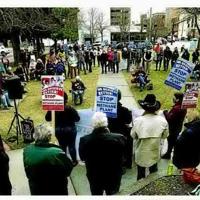NorthWestern Energy will ignite its controversial, recently constructed natural gas plant near Laurel this month.
While the electricity it produces is set to enhance Montana’s power grid during peak demand in the upcoming summer months, the debate over burning fossil fuels near the Yellowstone River remains heated.
Lawsuits are scheduled in Yellowstone County District Court Monday to determine the timeline for hearings on the latest lawsuit brought by neighbors of the power generation station just outside Laurel city limits.
NorthWestern acquired the land in 2021 to erect a 175-megawatt methane plant.
Local residents living in close proximity express concerns due to the plant’s location near the Yellowstone River and the fact that some of the land is designated for agricultural use.
Their opposition has led to legal challenges questioning the authority of local governments, the validity of land-use regulations, and growth planning decisions made for the Laurel area and the public’s right to participate meaningfully in the process.
People are also reading…
Despite the uncertainties, Montana’s largest public utility proceeded with its $310 million development, and the Yellowstone Generation Station began generating power earlier this year.
Although the monopoly utility is still entangled in legal, procedural, and regulatory challenges, the new plant is expected to be fully operational with the necessary federal and state permits sometime this month, according to NorthWestern spokeswoman Jo Dee Black.
The most recent lawsuit challenges the alterations to land-use maps and growth plans for the Laurel area. It alleges that the city and county violated Montana law in developing and adopting local regulations and policies, and failed to facilitate meaningful public engagement in the process.
Decision makers, side takers
Until recently, County Commissioner John Ostlund appeared in a promotional video for the Yellowstone Generation Station. After his participation in a corporate marketing campaign was questioned during a public hearing on April 2, it was promptly removed from NorthWestern’s website and YouTube account. The commissioner’s cameo has since been edited out of the video, with a revised version now available online.
Commissioner Mark Morse also publicly endorsed the Laurel plant, mentioning in an email to a NorthWestern manager that he had given it “a plug” during a Feb. 7 interview on a local radio show.
The lawsuit also raises concerns about conflicting land-use maps that displayed inconsistencies in zoning around Laurel following multiple changes made by city and county officials since 1979. Some amendments were documented with handwritten notes on paper copies, making them unclear, especially over time.
Court documents indicate that confusion surrounding the maps hindered public participation in the process NorthWestern is expected to undergo to ensure appropriate zoning for operating the plant.
Fear of a foregone conclusion
Last week, the Yellowstone County Commission took another step towards what some fear is an inevitable approval—the gas-burning electrical generation plant constructed on land designated for agriculture adjacent to the longest undammed river in the contiguous U.S.
On July 9, the three-member commission unanimously voted to adopt zoning for county-controlled land around Laurel that was previously believed to be in effect.
County Planning Manager Monica Plecker explained that a recent legal ruling determined that the zoning was not in place due to a lack of records, leaving the land unregulated. Thus, she recommended the commission adopt the zoning historically understood to be in place around Laurel.
“This decision is not about NorthWestern Energy,” stated Ostlund, the commission chairman. “The action we took safeguards all individuals who purchased zoned property in that area.”
Ostlund clarified that the decision formalized the existing zoning that landowners around Laurel already acknowledged. Rejecting the adoption would have left properties outside city limits unzoned, removing regulations distinguishing between different areas and potentially equating residential neighborhoods with industrial lots.
Concerns have also emerged regarding the ambiguity surrounding the zoning of NorthWestern’s Laurel property, with conflicting information provided by city and county officials. In addition, references to lost maps throughout the complex process only added to the confusion until the missing maps were recently located.
County leaders confirmed that NorthWestern’s property comprises agricultural, heavy industrial, and unzoned land. Nevertheless, Black expressed uncertainty about whether the utility will need to request a zone change to ensure compliance with the existing rules on the land where the plant is situated.
According to Black, NorthWestern selected the site due to its proximity to other industrial developments, the CHS refinery, and the Laurel wastewater treatment plant.
The utility intends to use the Yellowstone Generation Station to provide reliable power to Montana, particularly during peak demand periods brought about by extreme temperatures. It also serves as a backup for alternative energy sources like wind, solar, and hydropower, ensuring stability when renewable energy is less reliable.
Excess power generated for NorthWestern’s 405,500 customers in Montana can be sold to other utilities at higher prices, thereby reducing costs for NorthWestern’s ratepayers in 221 communities across the state.
During a recent public hearing, approximately a dozen individuals shared their views on the local government process and the handling of the situation by elected officials and NorthWestern representatives.
Kris Glenn, chairwoman of the Yellowstone Valley Citizens Council, emphasized the importance of clean air for individuals with respiratory issues and urged commissioners not to allow NorthWestern to pollute the Yellowstone valley, potentially undoing air quality improvements made over the past four decades.
Steve Fuller, a resident, expressed concerns about the environmental impact of a methane-burning plant near the river, highlighting potential risks to local water bodies, wildlife, and agriculture. He encouraged commissioners to consider the long-term costs to public health and the environment.
Permission first or forgiveness later
Steve Held, a former actor turned rancher, urged commissioners to consider the broader implications of air pollution on communities downwind of power plants like the one in Laurel. He emphasized the need for accountability and foresight in decision-making.
Mary Fitzpatrick, a member of the Northern Plains Resource Council, accused the commission of disregarding public sentiments and displaying bias towards the utility. She criticized the lack of transparency and alleged backroom dealings between NorthWestern and local officials.
Priscilla Bell, another council member, echoed similar sentiments regarding the decision-making process and the perceived lack of public input in crucial matters affecting the community.
Gene Jarussi, an attorney representing a group of residents in a lawsuit against the city and county, vowed to continue advocating for public participation and transparency in governance.
With ongoing legal challenges and public scrutiny, the future of the Yellowstone County Generation Station remains uncertain, as stakeholders continue to navigate the complex landscape of energy production and environmental impact.
R-E-S-P-E-C-T, sock it to me
As discussions persist and concerns mount, the Yellowstone County Generation Station serves as a focal point for broader conversations about energy, environment, and governance in Montana.





